by Karen Walker, Champaign IL
Like
any game, bridge is more fun if you play it well. Over 160,000 North American
bridge players have found that duplicate bridge is one of the best ways to
improve their skills and enjoy playing their favorite game. These
people compete in daily and weekly duplicate games -- some just for novices and
newcomers -- held in virtually every city (and many small towns) in the U.S.,
Canada and other countries. Almost all of these club games are open to anyone
who knows how to play beginning bridge.
It's called duplicate because each hand you play will be played at several other tables during the session, under the same conditions. Unlike rubber bridge, which depends heavily on being dealt good hands to win, your final score at duplicate depends only on how well you bid and play the cards you actually hold, not on how "good" those cards are.
You can play in a duplicate game without knowing anything about matchpoint scoring. As you become more experienced, though, you'll probably want to adopt some strategies that cater to this form of scoring. Later in this brochure, you'll find some tips on how to make "duplicate-style" bidding and play decisions that will improve your matchpoint scores.
The most common misconception about duplicate is that you have to be an experienced player or even an "expert" to enter the games. In fact, playing duplicate bridge is one of the best ways to become a better player.
The setup of a duplicate game gives you the opportunity to play against a wide variety of pairs -- from experts to bare beginners -- and to compare your bidding and play with theirs. Your mistakes (and your triumphs) will be clearer because you'll see how several other players bid and played the same cards you held. And because you have the chance to earn a top score on every hand (even if you hold a "Yarborough" with no honor cards), you'll be paying full attention to every trick!
This brochure will introduce you to duplicate game movements, scoring and strategies, but there's really no need to study before you play. The best way to enjoy duplicate is to just jump in and play in the games.
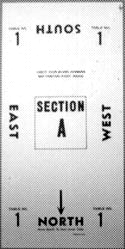 How a Duplicate Game Works
How a Duplicate Game WorksIn most movements of 7 tables or more, each NS pair stays at their starting table for the whole session. If you're seated NS, you'll play a round of 2 to 4 hands (also called boards) against the EW pair who starts there, then a new pair and new boards will come to your table for the next round. If you're EW, you'll move to a new table after every round to play new pairs and boards.
Games of 6 or fewer tables usually use a scrambled movement where all pairs change tables and directions after every round. The table cards will give you instructions about where to move for each new round.
The number of hands you play in a duplicate session will vary. You may play as few as 12-15 boards or as many as 28 (most clubs run sessions of 24-28 boards) and you'll play against from 5 to 13 other pairs. You don't need any special knowledge of how the game movement works. The director will handle the movement of pairs and boards, so all you have to do is play the people and the hands that come to your table.
 Each
hand you play will come to your table in a duplicate "board" -- a
plastic or metal tray
with a deck of cards already separated into the four hands. The board is
designed to keep each 13-card hand separate so other pairs can play the exact
same deal later in the session.
Each
hand you play will come to your table in a duplicate "board" -- a
plastic or metal tray
with a deck of cards already separated into the four hands. The board is
designed to keep each 13-card hand separate so other pairs can play the exact
same deal later in the session.
For the first round, you may receive pre-dealt boards that are ready to play. If not, you'll shuffle and deal the cards and place each hand into one of the four pockets in the board. This is the only time during the session that hands are shuffled.
All the boards for the round are stacked in the center of the table to match the directions on the table card.
In duplicate scoring, each hand stands alone. Partscores and vulnerability do not carry over to the next deal. Instead, each board has imprints that tell you the conditions for that hand only -- who the dealer is and whether each side is vulnerable. The NSEW directions are also marked on the board so you know which hand to take.

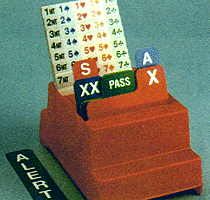 Bidding boxes
Bidding boxesMany clubs and most tournaments use bidding boxes, which allow you to make your bids with printed cards. Each table has four boxes, one for each player.
The back section of the box has a tiered stack of 35 bidding cards -- one for each of the 35 possible bids (1C through 7NT). The front section has several Pass cards (green), Double cards (red X) and Redouble cards (dark-blue XX). The box also includes a light-blue "A" card for use when you make an alertable call.
Instead of saying your bid out loud, you take the appropriate bid card (and all the cards behind it) from the back section of the box and place it on the table in front of you. If you want to open 1NT, for example, place your thumb on the tabbed 1NT card and pull it and all the cards behind it out of the box. You'll have a stack of five cards labeled 1C through 1NT, with the 1NT card on top.
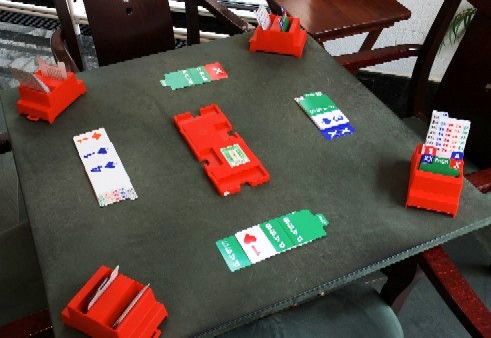 As you make subsequent
bids, place the new stacks of cards on top of those you've already used,
overlapping them so everyone can see all your previous bids.
As you make subsequent
bids, place the new stacks of cards on top of those you've already used,
overlapping them so everyone can see all your previous bids.
Pass, Double and Redouble cards are in the front of the box. If you want to make one of these calls, pull just that card out and place it in front of you, overlapping it with previous bidding cards.
When the auction is over and you're ready to begin play, return all the bidding cards to the back of the box (they'll already be in proper order). If you've used the smaller Pass, Double and Redouble cards, place them in the front of the box.
Players like bidding boxes because everyone at the table can always see all
the bids made in the auction. In addition to helping hearing-impaired players,
this method also saves time, reduces noise and prevents you from "mis-hearing"
a bid. Learning to bid this way takes just a minute or two.
If your local club has bidding boxes, the director or another player will show
you how to use them.
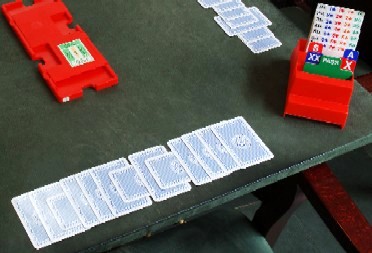 The bidding starts with the hand marked Dealer and progresses normally. Once
play begins, though, all four players must keep their original hands intact so
other pairs can play the exact same deal later. To keep your cards together and separate, play to each trick by placing your card face up
in front of you instead of in the middle of the table.
The bidding starts with the hand marked Dealer and progresses normally. Once
play begins, though, all four players must keep their original hands intact so
other pairs can play the exact same deal later. To keep your cards together and separate, play to each trick by placing your card face up
in front of you instead of in the middle of the table.
When the trick is complete, turn your played card face-down (still in front of you). If your side won the trick, place the card vertically (pointing toward you and partner). If you lost the trick, turn the card horizontally (pointing toward your opponents), overlapping cards as you finish tricks. This allows you to see how many tricks each side has won at any point in the play.
Although dummy doesn't make decisions during the play, he is responsible for handling his own cards and keeping track of the tricks won and lost. When you're declarer, you don't need to reach across the table to play from dummy. Just tell partner (dummy) which card you want to play to each trick ("small spade" or "play the ace", for example) and he'll detach the card for you.
All four players' played cards stay face-down in front of them, lined up so
everyone can always see how many tricks each side has won. When the play is
complete and both sides agree on the score, count your cards (to be sure none
got mixed in with another hand) and put your original hand back into the proper
pocket on the board.
The director sells entries, makes coffee, sets up the movement, scores the game and handles dozens of other jobs involved in running a duplicate game. The director will help you score, fill out a convention card and read the final tallies. Most will even answer your questions about bridge bidding and play.
The director is also there to make sure the game is fair for everyone. If something unusual occurs at your table -- a rule violation, a hand with only 12 cards, an incorrect score on a traveler, anything -- you should call the director to handle it. He uses a rule book to make standardized adjustments for irregularities in the bidding or play (a revoke or a bid out of turn, for example).
Since each deal is scored separately, duplicate gives no rubber bonus. Instead, you score an immediate bonus for each contract made, whether it's a partscore, game or slam. The bonuses are:
For all partscores: Trick score + 50 points
Non-vulnerable games: Trick score + 300 points
Vulnerable games: Trick score + 500 points
Penalties are the same as rubber scoring. Duplicate does not award points for holding honors.
The score for a 3D contract that makes exactly 3 would be +110 -- 60 for the trick score (3 x 20) plus 50 points for making a partscore. A vulnerable 4H game that makes an overtrick would be +650 -- 150 for the trick score (30 x 5) plus the 500-point game bonus.
Another difference is that a pass-out deal is not redealt, even if you're the first table to play the hand. The score is recorded as 0 for NS and EW.
You don't need to memorize the scores or even know how to figure them. Instead, you can refer to a printed scoring table that will be available at your club, or you can ask your opponents to score for you. If your club uses bidding boxes, you'll find all the scores for each contract on the back of the corresponding bidding card. A table of scores for all contracts is here: https://www.baronbarclay.com/product_images/uploaded_images/duplicate-score-chart.jpg
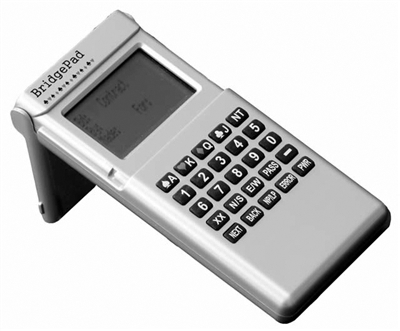 The player sitting North records the score for each deal.
Many tournaments and
clubs use wireless tabletop scorepads (photo at right) that transmit the contract
and result to a computer. Other clubs use paper pickup slips, which are
collected after each round.
The player sitting North records the score for each deal.
Many tournaments and
clubs use wireless tabletop scorepads (photo at right) that transmit the contract
and result to a computer. Other clubs use paper pickup slips, which are
collected after each round.
Another method is traveling scoreslips, one for each board, which is folded and put back into the board with the cards. When the board is played by other pairs, they'll enter their scores on the same traveling score. In later rounds, you'll be able to see the results from other tables and compare your scores with theirs.
Here's an example of a completed traveler from a 7-table game. If your club uses wireless scorepads, the printout of each table's results will be similar to this format.
TRAVELING SCORE: BOARD # 1
| | | | | | SCORE | | Match | |NS#| Contract| BY|Made|Down| NS + | EW + |EW#| points| | 1 | 4H | S | 5 | | 450 | | 1 | 6 | |---|---------|---|----|----|------|------|---|-------| | 2 | 4H | S | 4 | | 420 | | 3 | 4 1/2 | |---|---------|---|----|----|------|------|---|-------| | 3 | 4H | S | 4 | | 420 | | 5 | 4 1/2 | |---|---------|---|----|----|------|------|---|-------| | 4 | 3NT | N | | 2 | | 100 | 7 | 0 | |---|---------|---|----|----|------|------|---|-------| | 5 | 3NT | N | 3 | | 400 | | 2 | 3 | |---|---------|---|----|----|------|------|---|-------| | 6 | 4S DBL | E | | 2 | 300 | | 4 | 2 | |---|---------|---|----|----|------|------|---|-------| | 7 | 3H | S | 4 | | 170 | | 6 | 1 | |---|---------|---|----|----|------|------|---|-------|
Each of the seven North players filled in the contract, declarer, number of tricks made or down, the score and the pair number of their EW opponents. The last column shows the N-S matchpoint score, which the director (or the club computer) figures after the game.
North scores on the line number that matches his pair number. He fills in the East-West pair number in another column on the right. If North-South earns a plus score, the result is recorded in the NS+ column. If East-West gets the plus score, it's placed in the EW+ column.
The last column has each NS pair's matchpoint score for this board. This score, which shows the number of pairs you beat, is figured by the computer (or manually by the director) after all scores are in.
Your result on each hand is compared only with the pairs who held the same cards and sat the same direction (NS or EW) you did. On the traveler above, if you were NS #1, your +450 (for 4H making 5) would earn you a top score of 6 because it beat all six of the other NS scores. Your opponents on this hand (EW #1), scored 0 because all other EW pairs did better. EW #7 earned the EW top score of 6.
The matchpoints for each board are added up and pairs are ranked by total score. If you play 28 hands in a 7-table game, the average total score is 84 (28 hands x 3, the average matchpoint score on each hand). Players call this average score a "50-percent game". A 60-percent score will usually win; 55 percent will place in the top three or four.
The director may do all the scoring by hand, but most clubs use computers. The computer takes results from each table (sent by wireless scorepads or entered by the director from the paper scoreslips) to figure matchpoints, total scores and rankings of all pairs. The final scores will be available within minutes (or seconds) after you play the last hand.
All pairs' scores and rankings will be displayed on a large "recap sheet" the director will post after the game. In most games, there will be separate sheets for NS and EW. Each sheet will list all the pairs that played that direction, their matchpoint scores and percentages, their ranking in the section, and the number of masterpoints they won. Below the pair listing will be grid that shows the result and matchpoint score for every hand at every table. Ask the director or another player for help if you'd like to learn more about how to read the results.
The computer can give you a computer printout of your pair's results and matchpoint scores on each hand. Many clubs also post the scores -- sometimes with hand diagrams -- on the Internet.
Winners and runners-up in each game are awarded
official masterpoints from the American Contract Bridge League (ACBL). If your
club uses a computer and if you're an ACBL member, your club director will send
your points directly to ACBL. A report of points you've won is printed in every issue of
the Bridge Bulletin, the monthly magazine
that's mailed to all members.
Filling out this card before the game is a good way for you and partner to discuss your bidding system. The card's main purpose, though, is to inform your opponents about your agreements.
During the game, you can consult your opponents' convention card (or ask them directly at your turn to bid) if you have a question about the meanings of any of their bids. The card will tell you about key areas of their bidding system -- for example, the point range for their opening notrump bids and if they use Weak or Strong Two-Bids, Negative Doubles and other conventions.
The card contains space for all the possible agreements a pair might have. Beginners who play a simple Standard American system need to mark only a few boxes. The first time you play, the director or another player can help you fill out the card, which takes just a few minutes.
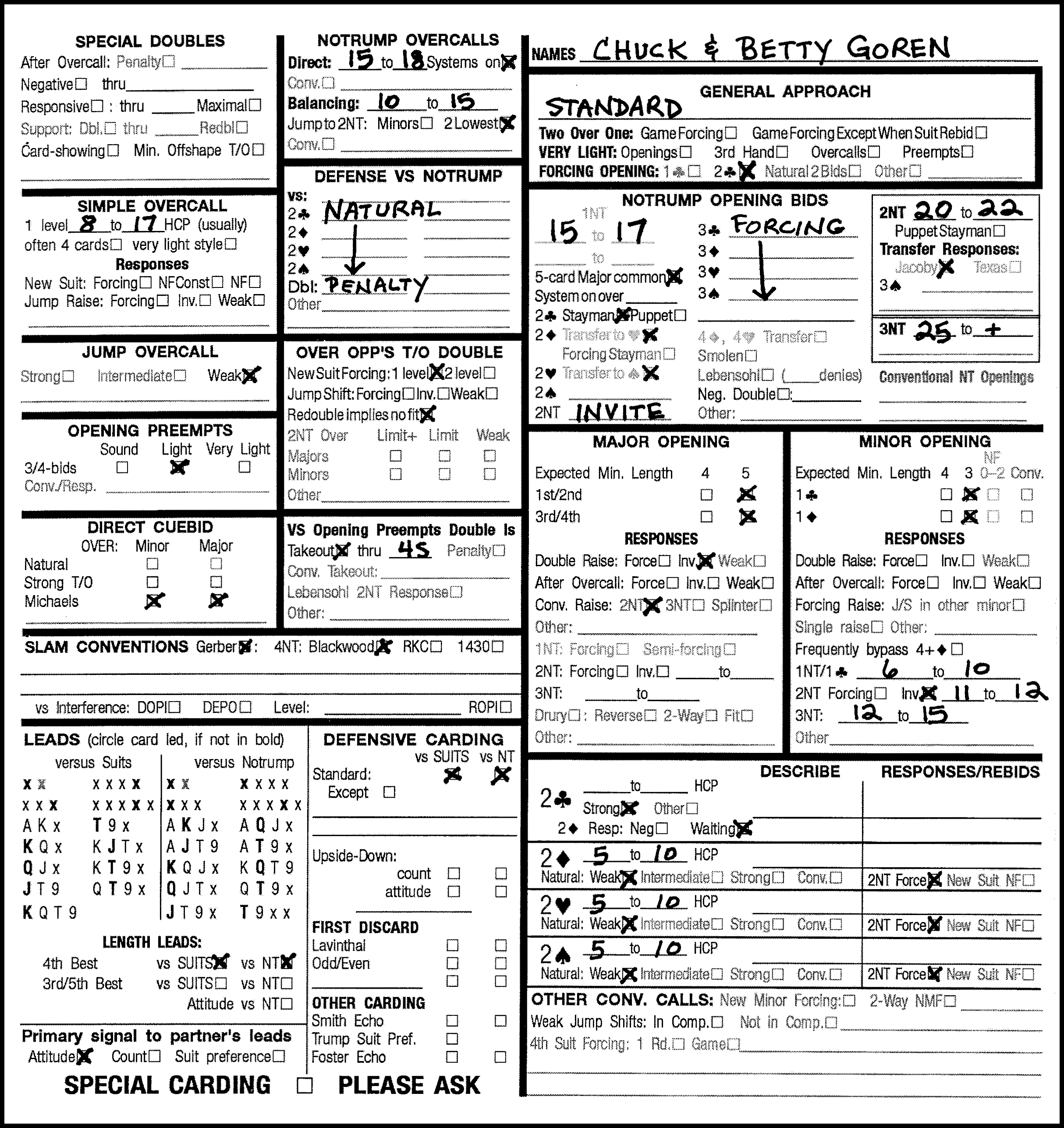 Blank convention cards will be available at your club or you can copy the
card here. It's already filled out for a basic system with Weak Two-bids, Jacoby
Transfers, Jacoby 2NT, limit raises and 15-17 1NT openings. If you're filling
out a blank card, or if you want to add to the sample card, the main sections to
mark are:
Blank convention cards will be available at your club or you can copy the
card here. It's already filled out for a basic system with Weak Two-bids, Jacoby
Transfers, Jacoby 2NT, limit raises and 15-17 1NT openings. If you're filling
out a blank card, or if you want to add to the sample card, the main sections to
mark are:
NOTRUMP OPENING BIDS: The point range is filled in for 1NT, 2NT and 3NT opening bids. There are also checkmarks in the boxes for Stayman (2C response to 1NT) and Jacoby transfers (2D and 2H).
MAJOR OPENINGS: The marks in the "5" boxes indicate that you promise 5+ cards for 1H and 1S openings. The checks in the "Inv" boxes show that a double raise of opener's suit (1S-3S) is invitational. The check in the "2NT: Forcing" box is for the Jacoby 2NT forcing raise.
MINOR OPENINGS: The "3+" boxes show the minimum length for 1C and 1D opening bids. Mark "Inv" (invitational) to show that a double raise (1C-3C) is invitational. Below this are the point ranges for responses of 1NT, 2NT and 3NT to a minor-suit opener.
2C, 2D, 2H, 2S: The card is filled out for Strong 2C openings and Weak Two-bids with the 2NT asking response. If you play all your two-bids as strong and forcing, mark the "Strong" boxes and add "2NT weak" for responses.
OTHER CONVENTIONAL CALLS: If you play New Minor Forcing, check the box here. You can use this space to note any other bidding agreements that aren't covered by other areas of the card.
SPECIAL DOUBLES: Check the "Negative" box if you play negative doubles and indicate how high they are "on" (common is through the 3S level).
NOTRUMP OVERCALLS: These are point ranges for a direct 1NT overcall and a balancing 1NT in the pass-out seat (1C-P-P-1NT). If you play Unusual 2NT overcalls, check the "2 Lowest" box.
SIMPLE OVERCALL: This is the point range you promise for a simple (non-jump) suit overcall (usually around 8-17 points).
JUMP OVERCALL: The "Weak" box shows that your jump overcall (1S on your right, 3C by you) is a weak preempt (6+-card suit, 5-9 points).
OVER OPPONENT'S TAKEOUT DOUBLE: If partner opens and your RHO makes a takeout double, your l-level bid of a new suit forces opener to bid again. A 2-level bid does not (it promises a long suit and 5-9 points). Redouble by you shows 10+ points and implies no fit for partner's suit.
DEFENSE VS. 1NT: This describes the meanings of your overcalls after an opponent opens 1NT. "Natural" means you play no conventional meanings.
OPENING PREEMPTS: Most players mark the "Light" box. If your opening 3-bids routinely show as many as 10 points, though, mark the "Sound" box.
DIRECT CUEBID: This explains the meaning when you bid the suit your opponent opened (1H on your right, 2H by you, or 1C-2C). If you play Michaels two-suited overcalls, mark those boxes.
LEADS: Circle the card you would lead from each of the listed examples. The standard lead from each holding is printed in boldface, so if that card is the one you would lead, you don't need to mark it. At the bottom, circle "4th Best" to indicate the card you lead from a long suit.
The private score
On the back (inside) of the convention card is space for you to record your score on each hand. This part of the card is "unofficial" -- it's for your use only, so you can write in anything from the contract and score to a description of your opponents.
The private score is a handy reminder if you want to discuss the hands with your partner or other players after the game. Since this part of the card has information on hands your opponents may not have played yet, be sure to keep your card folded so this part isn't visible to anyone else during the game.
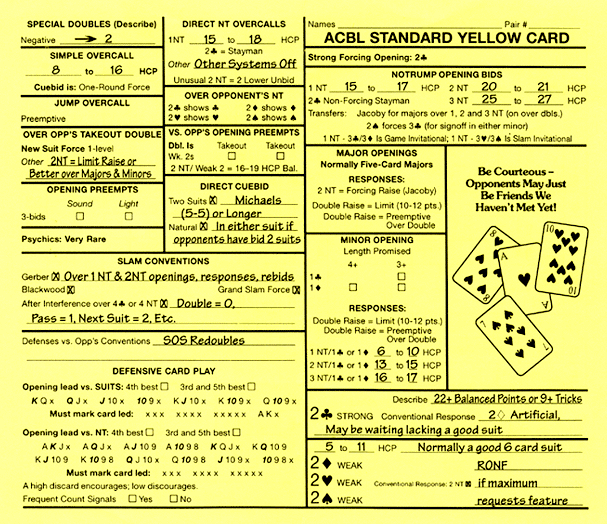 The SAYC convention card
The SAYC convention card
A handy bidding system for new partnerships is the Standard American Yellow Card (SAYC).
This is a 5-card major system that includes several simple, widely played conventions. They include Jacoby transfers, limit raises, Jacoby 2NT forcing raise, weak 2-bids, Michaels and negative doubles.
SAYC is one of the most popular systems used by players in Internet bridge clubs. If you play online, you may find it helpful to familiarize yourself with the SAYC conventions.
The card at right is already filled in with all the SAYC agreements
and conventions. If your club doesn't have copies of this card, you can print
this one and use it to discuss a simple system with your partner.
 Matchpoint
Tips & Strategies
Matchpoint
Tips & StrategiesFirst and foremost, remember that duplicate is bridge. It doesn't require you to learn a new bidding system. The only real change is in how your final result is scored. Your matchpoint score is based not on how much you beat the other pairs by, but on how many pairs you beat.
This one difference from rubber bridge can affect a number of your decisions during the bidding and play. Here are some tips that will help you adapt your style to matchpoint scoring:
When you're comfortable with the basics, consider adding other bidding tools played by duplicate pairs. Some of the most popular -- and easiest to learn -- are Weak Two-bids, Jacoby Transfers and two-suited overcalls (Michaels cuebids and the Unusual 2NT). Among the most valuable are New Minor Forcing and Negative Doubles. Take care, though, not to overload your brain with too many new toys. Add just one new bid at a time and practice with it until you feel ready for another challenge.
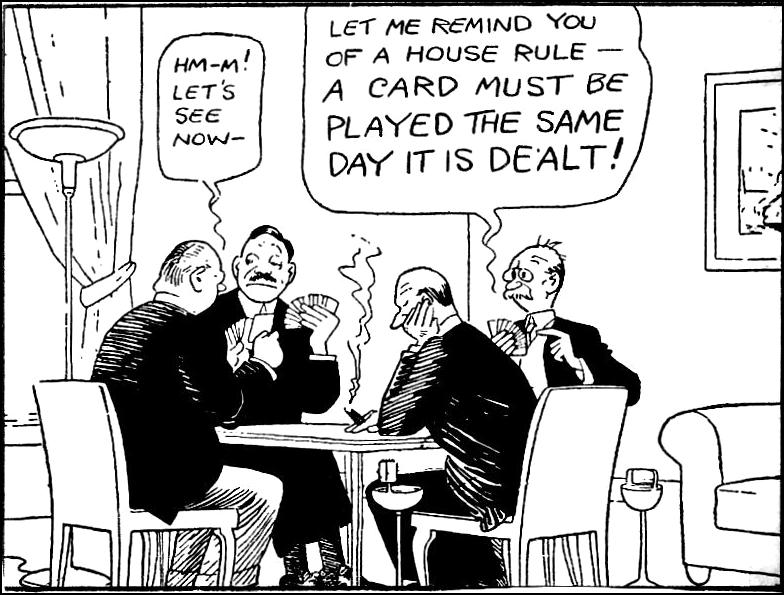 Duplicate
Customs
Duplicate
CustomsLocal duplicate clubs offer a social, friendly atmosphere, but the bridge played there is a competition, so the players follow rules designed to ensure an even playing field. The "coffeehousing" that is sometimes accepted in a home game is understandably off-limits at duplicate. Some other customs and matters of "etiquette" you'll want to follow include:
Jacoby 2NT (forcing major-suit raise). All of opener's rebids after 2NT are also alertable.
Jacoby Transfers (after partner opens 1NT). When this bid is made, the partner of the bidder announces its meaning by saying the name of the suit it shows (after 1NT-Pass-2D, opener announces "Hearts" instead of saying "Alert" or "Transfer").
1NT opening bids. Since different pairs play different point ranges for 1NT, the partner of the 1NT opener announces the point range ("15 to 17" or "12 to 14", for example).
Forcing 1NT response (used in the 2-over-1 system after partner opens 1H or 1S). This is another "announceable" bid. To let you know he is forced to bid again, opener will simply say "Forcing" when his partner responds 1NT.
 You're ready!
You're ready!Club and tournament players will tell you that once you experience the excitement and challenge of duplicate, party bridge will pale by comparison. The only way to find out is to try it for yourself.
Duplicate bridge is love at first deal for many rubber-bridge players. For others, it's an acquired interest that takes some time to develop. To find out how much enjoyment the game can offer, you need to give it a chance and play several times.
You can play in both the novice and open games at your local club. If you don't have a partner, call the director and ask to be matched up. If there's a tournament in your area, don't be afraid to give it a try, too. Tournaments are not just for experts. In fact, almost all tournaments cater to newcomers by offering special novice sections and point awards.
You probably won't win the first few times you play. And if you're like most new players (remember that everyone at the game was a once a first-timer), you'll come in last. But as you get to know the people and become more comfortable with the scoring and play -- and experience the excitement of winning your first masterpoints -- you'll be glad you kept trying. And you'll probably find your rubber-bridge game improves dramatically, too!
 "Of all competitive activities, bridge is unique because it offers you the
opportunity to improve by competing against better players. The amateur golfer
can't play a foursome with Nicklaus; the average tennis player could never hope
for a match against Navratilova. But even novice bridge players can sit down at
a tournament and play against experts and world champions."
"Of all competitive activities, bridge is unique because it offers you the
opportunity to improve by competing against better players. The amateur golfer
can't play a foursome with Nicklaus; the average tennis player could never hope
for a match against Navratilova. But even novice bridge players can sit down at
a tournament and play against experts and world champions."
-- Mike
Lawrence, bridge author & world champion
Copyright © Karen Walker kwbridge@comcast.net
Back to Karen's Bridge Library